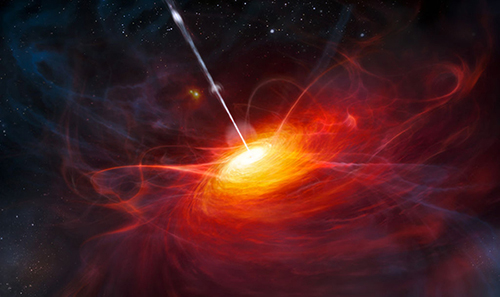With the launch of the next-generation James Webb Space Telescope in October 2021, astronomers will finally be able to perceive distant galaxies that host quasars—the most luminous objects in the universe. Quasars shine forth with the equivalent brightness of trillions of Suns. As a result, quasars outshine their host galaxies to such a degree that the galaxies themselves are mostly lost in the glare when viewed with current telescopes. With the next-generation Webb telescope, however, researchers can hope to learn a great deal more about quasars' cosmic environments and how these extreme objects form. See also: Galaxy; Galaxy formation and evolution; Quasar; Sun; Telescope

Found almost exclusively in very distant, young galaxies, quasars are supermassive black holes that actively devour matter. The matter is accelerated by the black holes' powerful gravity to near-light-speed, smashing into other matter and unleashing a tremendous amount of energy. A longstanding mystery is how these supermassive black holes could have developed so early in cosmic history when the universe was only around a billion years old. Although thought to be on the order of the size of our solar system, such black holes contain billions of times the Sun's mass. Scientists have struggled to develop models that account for the enormous amount of mass that accumulated in so small an area within so short a time span. See also: Black hole; Cosmology; Mass; Solar system
Clearly discerning the comparatively faint galaxy surrounding a quasar is beyond the capabilities of current ground-based telescopes and space-based telescopes, including the Hubble Space Telescope. Recent research, however, suggests that Webb will be up to the task. In a series of simulations, researchers modeled the observing capabilities of Webb on distant, quasar-hosting galaxies previously observed by Hubble. The simulations showed that Webb should be able to distinguish the galactic host from an embedded, superbright quasar. This is in large part because Webb features a primary mirror 6.5 m (21 ft) across compared to Hubble's 2.4-m- (8-ft-) diameter mirror, offering seven times the light-collecting area. Webb is also going to view the universe in infrared wavelengths not available to Hubble, which can better pass through cosmic dust. Overall, the James Webb Space Telescope looks poised to provide new key data on the poorly studied environments where quasars develop and activate. See also: Astronomical observatory; Hubble Space Telescope; Infrared astronomy; Light





